Computex 2002 Day 1 - Part II: KT400, Dual Channel DDR & More
by Anand Lal Shimpi on June 3, 2002 11:55 AM EST- Posted in
- Trade Shows
Gigabyte is on top of things: KT400, Hammer & Granite Bay boards displayed
This first appeared on the AnandTech Newsletter. Click Here to Sign up.
Although we didn't visit many motherboard manufacturers on the first day of Computex, we made certain to pay Gigabyte a visit. Last year we could find virtually every motherboard we were interested in at Gigabyte's suite and the situation is no different in 2002.
The first on Gigabyte's long list of boards were Socket-754 (ClawHammer) boards featuring AMD's 8000 and VIA's K8HTA chipsets. The AMD 8000 based board was actually functional and running in Gigabyte's labs although admittedly not very stable. It is entirely too early to expect a stable showing from most of these motherboards and definitely too early to start talking about performance but with a launch somewhere between October and December of this year it's good to see such open support for the Hammer platform.
An interesting thing to note is that the board is currently spec'd with support for three ATA-133 channels and two Serial ATA connections on-board. Also worth noting is the placement of the AGP controller (covered by the Gigabyte heatsink) in relation to the CPU socket, memory banks and AGP slot. Since there's no direct link between the chip and main memory (unlike conventional North Bridges), the chip is placed much closer to the AGP slot and the CPU.
Gigabyte also had a VIA based Socket-754 board on display although it was definitely not as far along in the testing cycle as the AMD-8000 board. Gigabyte anticipates having both AMD and VIA based solutions at launch but no mention about ALi, SiS or NVIDIA solution; you should keep in mind that Gigabyte historically hasn't worked with any of the other chipset manufacturers however.
VIA's KT400 can be seen on a number of motherboards on the show floor although the chipset won't be ready until late July at the earliest. From talking to Gigabyte they seem to be betting on an August launch for the chipset. The new North Bridge should offer a P4X333-class memory controller with DDR400 and AGP 8X support. We haven't seen a single demo of DDR400 at Computex thus far that was actually running at DDR400 speeds however. Both the VIA and SiS chipsets that offer DDR400 support aren't currently stable enough in order to allow for a demonstration.
Gigabyte wasn't too exited about KT400 stating that the chipset's costs are noticeably greater than KT333 with minimal performance benefits, not to mention that prices for DDR400 memory will most likely be astronomical upon the chipset's launch.
Although Intel has yet to announce the chipset, it seems like AMD's openness with non-shipping products (Hammer) may be rubbing off on Intel when it comes to their Granite Bay chipset. The Granite Bay chipset will be launching either late this year or by Q2 next year and is the first dual-channel DDR solution for the desktop Pentium 4. The chipset will mark Intel's phase-out process of RDRAM from the desktop market for the foreseeable future. Other than a dual-channel DDR memory controller, the chipset also supports AGP 8X and will be aimed at high-end desktop and workstation systems.
The Granite Bay Memory Controller Hub (MCH) has a noticeably larger die than all other Pentium 4 chipsets and also boasts a much larger substrate surface area. The reason for the larger substrate is because of the fact that there are physically many more wires to route with a dual-channel 64-bit DDR memory controller than with a dual-channel 16-bit RDRAM controller (e.g. 850E)
 .
.
At last year's Computex Gigabyte effectively cut ties with NVIDIA by agreeing to produce ATI based graphics cards. ATI seems quite pleased with them and has asked Gigabyte to produce a higher clocked version of the Radeon 8500. The card is called the Radeon 8500XT Ultra and runs at 300MHz core with 300MHz DDR SDRAM (3.3ns); this is an increase of approximately 9% over the default 275/275MHz Radeon 8500 clock. The board is outfitted with 128MB of 300MHz DDR memory.
Continuing with their support for ATI, Gigabyte also had a Radeon IGP board on display. Gigabyte felt (much like we do) that the Radeon IGP has very little business being in the desktop market and is a much better match for the mobile market that ATI seems to be targeting it at. Nonetheless, a board was on display but it was clearly not as prominent as the other boards we saw from Gigabyte.


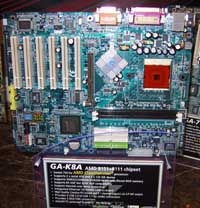
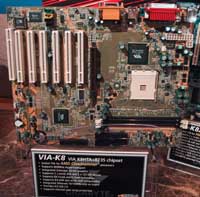
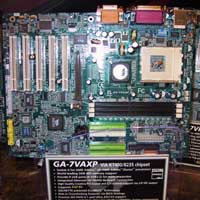
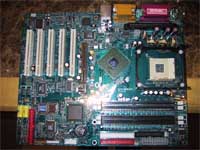
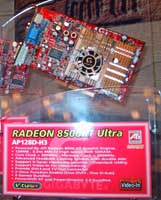
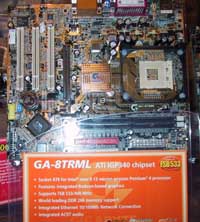








0 Comments
View All Comments